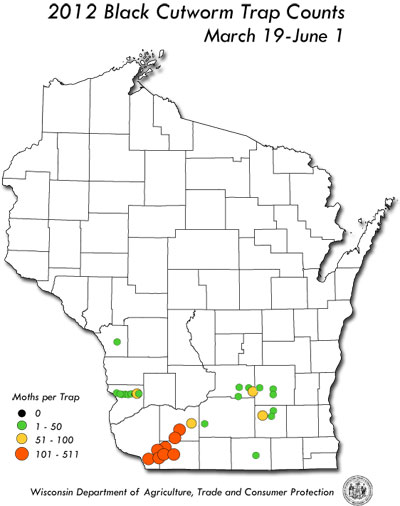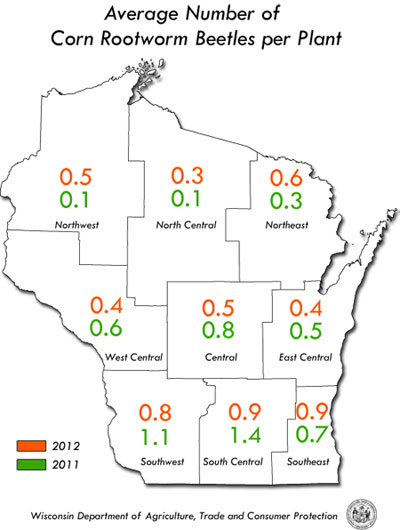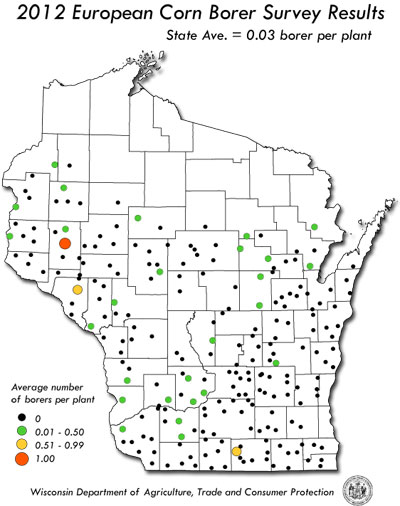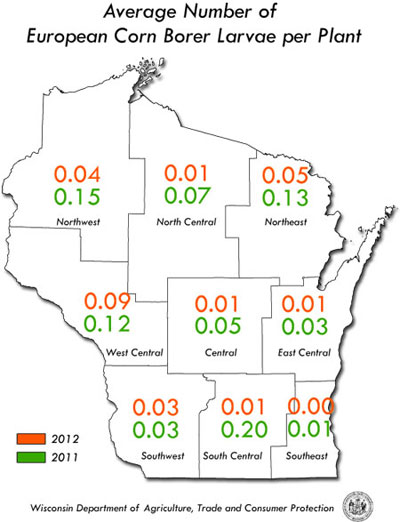
 |
|
|
Corn
Volume 57 Number 21 Date 11/08/2012 BLACK CUTWORM - Migrants arrived in remarkably high numbers this year. The network of 31 pheromone traps distributed in southern Wisconsin registered a cumulative total of 2,601 moths from March 19-June 1, with a peak occurring from May 1-16. Localized infestations developed in corn by mid-May in Dane, Rock, Sauk and Walworth counties as a result of the large migration and favorable field conditions. Damage to late-planted corn was also reported from Manitowoc and Sheboygan counties in early June. Infestation rates ranged from 3% cut plants to as high as 22% in exceptional fields. Summarized in the map below are the spring 2012 moth counts. CORN ROOTWORM - The annual survey conducted in August found a minor decrease in the state average number of beetles per plant. Population reductions were charted in five of the nine crop reporting districts, while increases occurred in the northern and southeastern areas. The state average of 0.6 beetle per plant compares to 0.7 last season and a 10-year average of 0.9 per plant. District counts were as follows: northwest 0.5, north-central 0.3, northeast 0.6, west-central 0.4, central 0.5, east-central 0.4, southwest 0.8, south-central 0.9, and southeast 0.9. Beetle counts in all three northern districts increased markedly from very low 2011 levels, but remained below the economic threshold of 0.75 beetle per plant. Economic populations were noted in 25% of the 229 fields surveyed. Results of the survey indicate a high potential for larval root injury to non-Bt, continuous corn in southern Wisconsin next season and a low to moderate risk elsewhere. Corn producers in the south are advised to consider crop rotation, planting a Bt-rootworm hybrid or another form of rootworm management in 2013. CORN EARWORM - The primary flight began by June 27 and continued through mid-September. Moth collections fluctuated in July and August and peaked from August 24-September 5, with weekly counts ranging from 809-2,545 moths per trap at the Fond du Lac County monitoring locations. The twelve-week migration yielded a cumulative total of 10,656 moths at 15 sites, which is a 57% increase over the 4,571 moths at 15 sites in 2011. Late-season flights were much larger than last year, although most of the moths arrived after sweet corn was well past the critical silking stage. EUROPEAN CORN BORER - Larval populations declined to the lowest level in the history of Wisconsin European corn borer surveys. The seventy-first annual fall abundance survey in October found a state average of only 0.03 borer per plant, the lowest since 1942. Populations decreased from 2011 in eight of the nine crop reporting districts, the exception being the southwest where the average remained unchanged at 0.03 borer per plant. The highest district average of only 0.09 borer per plant was noted in the west-central area. Research has demonstrated that the historically low European corn borer populations documented in Wisconsin and the Midwest during the last several years are directly associated with increasing, widespread Bt corn use. This year's already low population was likely further reduced by the summer drought. WESTERN BEAN CUTWORM - According to the 2012 trapping program results, the moth flight peaked 2-3 weeks earlier and was slightly smaller than that of 2011. The average number of moths per trap was 25, a minor decrease from 28 per trap last year. The 2012 state count of 3,290 moths compares to 4,895 moths in 2011, 10,807 moths in 2010 and 4,928 moths in 2009. Infestations resulting from the flight were generally minimal again this season. Most larvae were fully developed and had entered the pre-pupal overwintering stage by mid-August. -- Krista Hamilton, DATCP Entomologist 





|
|
|